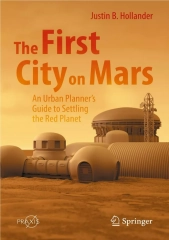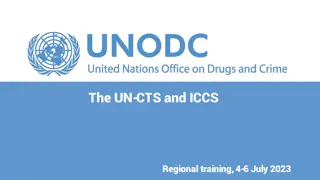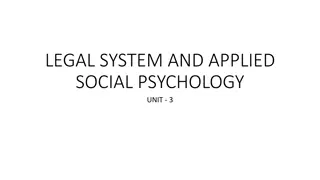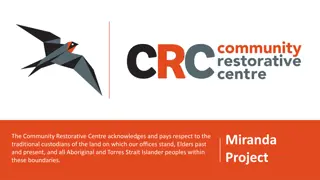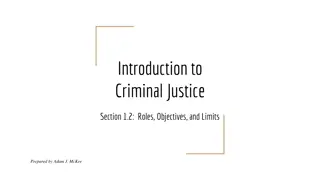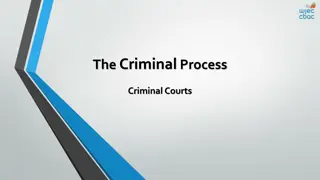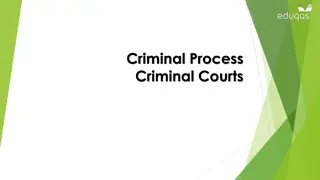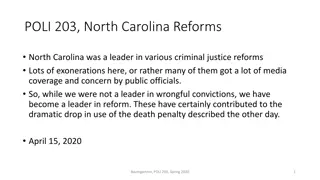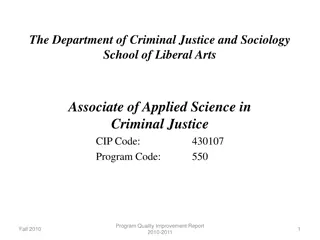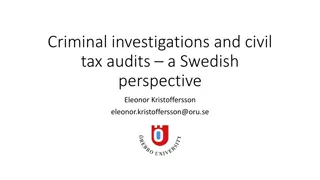CDVSA Criminal Justice Planner Update - Program Updates & Partnerships
This update highlights program updates such as Battering Intervention Program Regulations, OVW Restorative Justice Pilot Project, and more collaboration efforts to address domestic violence issues in Alaska through various initiatives and partnerships.
Uploaded on Mar 22, 2025 | 2 Views
Download Presentation

Please find below an Image/Link to download the presentation.
The content on the website is provided AS IS for your information and personal use only. It may not be sold, licensed, or shared on other websites without obtaining consent from the author.If you encounter any issues during the download, it is possible that the publisher has removed the file from their server.
You are allowed to download the files provided on this website for personal or commercial use, subject to the condition that they are used lawfully. All files are the property of their respective owners.
The content on the website is provided AS IS for your information and personal use only. It may not be sold, licensed, or shared on other websites without obtaining consent from the author.
E N D
Presentation Transcript
New Ideas Track: Testing MapReduce-Style Programs Christoph Csallner, Leonidas Fegaras, Chengkai Li Computer Science and Engineering Department University of Texas at Arlington (UTA) European Software Engineering Conference / ACM SIGSOFT Symposium on the Foundations of Software Engineering ESEC/FSE, Szeged, Hungary, Thursday, Sep. 8, 2011
Since 2004: Many MapReduce systems, papers & users Google MapReduce Apache/Yahoo! Hadoop http://wiki.apache.org/hadoop/PoweredBy Microsoft Dryad http://research.microsoft.com/en-us/projects/dryad/ Apache/Yahoo! Pig https://cwiki.apache.org/confluence/display/PIG/PoweredBy Apache/Facebook Hive https://cwiki.apache.org/confluence/display/Hive/PoweredBy [OSDI 2004] > 2,000 cit. [EuroSys 2007] > 500 cit. [SIGMOD 2008] > 400 cit. [VLDB 2009] Testing MapReduce-style programs 1
MapReduce programming model Programmer implements sequential code Two functions: map and reduce For example, in sequential Java code System distributes, schedules, handles faults Invokes map on many nodes in parallel Collects and re-distributes intermediate results Invokes reduce on many nodes in parallel Programmer can focus on problem domain Testing MapReduce-style programs 2
Map: Group By Key Reduce: avg of first 3 Input Output (key;value)* ...;dept; salary ...; A; 250,000 ...; X; 220,000 ...; F; 220,000 ...; Z; 210,000 ... A; 250,000 X; 220,000 F; 220,000 Z; 210,000 ... A; 250,000 A; 150,000 A; 140,000 A; 95,000 ... 180,000 O; 150,000 T; 150,000 A; 150,000 A; 140,000 ... ...; O; 150,000 ...; T; 150,000 ...; A; 150,000 ...; A; 140,000 ... B; ... ... ... C; ... ... ... ...; E; 100,000 ...; S; 100,000 ...; A; 95,000 ...; C; 95,000 ... ... E; 100,000 S; 100,000 A; 95,000 C; 95,000 ... ... ... Testing MapReduce-style programs 3
Map: Group By Key Reduce: avg of first 3 Input Output (key;value)* ...;dept; salary ...; A; 250,000 ...; X; 220,000 ...; F; 220,000 ...; Z; 210,000 ... A; 250,000 X; 220,000 F; 220,000 Z; 210,000 ... A; 250,000 A; 95,000 A; 150,000 A; 140,000 ... 180,000 165,000 O; 150,000 T; 150,000 A; 150,000 A; 140,000 ... ...; O; 150,000 ...; T; 150,000 ...; A; 150,000 ...; A; 140,000 ... B; ... ... ... C; ... ... ... ...; E; 100,000 ...; S; 100,000 ...; A; 95,000 ...; C; 95,000 ... ... E; 100,000 S; 100,000 A; 95,000 C; 95,000 ... ... ... Testing MapReduce-style programs 4
Example bug: /* Report avg of top-3 salaries, if avg>100k */ publicvoid reduce(String dept, Iterator<Integer> salaries) { int sum = 0; int i = 0; while (salaries.hasNext() && i<3) { sum += salaries.next(); i += 1; } emit( (i>0 && sum/i > 100000)? sum/i : -1); } Code depends on order of salaries, just uses first-3 Programmer may be confused by order of salaries in input files, that order is not maintained Bug, possibly because MapReduce systems have built-in ordering, but not always use them Testing MapReduce-style programs 5
User reduce program has to satisfy correctness conditions Reduce must not rely on a particular order: For each input list of values L, for each permutation P: reduce(key, L) == reduce(key, P(L)) Program also has to satisfy other MapReduce- specific correctness conditions Current tools do not check these conditions Testing MapReduce-style programs 6
Goal: Find such bugs automatically Find an input list of values L and a permutation P: reduce(key, L) reduce(key, P(L)) Current tools do not find such bugs There are many input lists and permutations Trying all of them is impossible Testing MapReduce-style programs 7
Example bug: /* Report avg of top-3 salaries, if avg>100k */ publicvoid reduce(String dept, Iterator<Integer> salaries) { int sum = 0; int i = 0; while (salaries.hasNext() && i<3) { sum += salaries.next(); i += 1; } emit( (i>0 && sum/i > 100000)? sum/i : -1); } Need specific list of salaries & permutation List of more than 3 elements Average of first 3 elements > 100k Permutation has to swap element at position 3 with element at position>3 Testing MapReduce-style programs 8
Observations Example MapReduce programs are typically small and contain few execution paths How do industrial MapReduce programs look like? Dynamic symbolic execution may be a good fit Heavy-weight but precise analysis Systematically explores all execution paths Well-suited for reasoning about few paths reduce(key, L), reduce(key, P(L)) may trigger different execution paths Not enough to analyze one path at a time Testing MapReduce-style programs 9
Check correctness conditions with dynamic symbolic execution 1. Derive symbolic path condition, return value 2. Maintain them in an indexed execution tree Index leaf nodes by length of input list Sibling(path): Triggered by input list of same length 3. Encode potential violation of correctness condition in constraint system Solving constraints with off-the-shelf constraint solver yields concrete input values L and permutation P 4. Convert solution to test case, run, confirm violation Testing MapReduce-style programs 10
Encode correctness conditions in symbolic program constraints // Permutation P as a function: 0 p[0], 1 p[1], .. // Symbolic list L = L[0], L[1], .. SymbolicInt[] p SymbolicIndices; // distinct list positions Assert PathCond; Assert SubstituteIndices(SiblingPath, p); // e.g.: L[p[0]]==5 P(L) = L[p[0]], L[p[1]], .. // e.g.: L[0]==5 // Find a concrete list + a concrete permutation such that: // reduce(key, list) reduce(key, permutation(list)) Assert Result SubstituteIndices(SiblingResult, p); Testing MapReduce-style programs 11
Input length heuristic Pick representative input lengths Initially: |L| := 2 For shorter lists: L == P(L) Binary back-off scheme Each subsequent iteration doubles length of L Testing MapReduce-style programs 12
Conclusions New programming paradigm with new bugs To produce deterministic results, a MapReduce system requires user programs to satisfy certain high-level correctness conditions Neither MapReduce execution systems nor tools check these conditions Proposed approach: Encode MapReduce correctness conditions in symbolic program constraints Check correctness conditions at runtime Testing MapReduce-style programs 13
References [OSDI 2004] J. Dean and S. Ghemawat. MapReduce: Simplified data processing on large clusters. In Proc. 6th USENIX Symposium on Operating Systems Design and Implementation, pages 137 150. [EuroSys 2007] M. Isard, M. Budiu, Y. Yu, A. Birrell, and D. Fetterly. Dryad: Distributed data-parallel programs from sequential building blocks. In Proc. 2nd ACM SIGOPS European Conference on Computer Systems, pages 59 72. [SIGMOD 2008] C. Olston, B. Reed, U. Srivastava, R. Kumar, and A. Tomkins. Pig latin: A not-so-foreign language for data processing. In Proc. 34th ACM SIGMOD International Conference on Management of Data, pages 1099 1110. [CACM2008] J. Dean and S. Ghemawat. MapReduce: Simplified data processing on large clusters. Communications of the ACM, 51(1):107 113. [VLDB 2009] A. Thusoo, J. S. Sarma, N. Jain, Z. Shao, P. Chakka, S. Anthony, H. Liu, P. Wycko, and R. Murthy. Hive: A warehousing solution over a map-reduce framework. Proc. VLDB Endowment, 2(2):1626 1629. Testing MapReduce-style programs 14
Questions Testing MapReduce-style programs 15
MapReduce used for variety of jobs Process web-scale data (PB = peta-byte = 1015) Run on many machines in parallel Google: Process 20 PB per day [CACM2008] 10k programs build search index, process text, graphs, etc. New York Times: Convert 4TB of articles to PDF http://open.blogs.nytimes.com/2007/11/01/self-service-prorated-super-computing-fun/ Yahoo!: Sort TB in 209 seconds: http://sortbenchmark.org/ First time that either a Java or an open source program has won this challenge [http://hadoop.apache.org/] Facebook: Hive-based data warehouse Testing MapReduce-style programs 16
MapReduce map-reduce MapReduce: Inspired by functional programming map-reduce But different For detailed comparison, see: Ralf L mmel. Google's MapReduce programming model Revisited. Science of Computer Programming 68(3): 208 237. Oct. 2007. Testing MapReduce-style programs 17
MapReduce correctness condition 2: Optional combine function Combine: programmer-defined sequential code Similar to map and reduce May be invoked on Map node, after map Locally pre-reduce results, by key Reduce transmission overhead to real reduce System can invoke combine 0 n times Must not affect semantics Similar approach: Encode in symbolic path condition, result value Testing MapReduce-style programs 18


